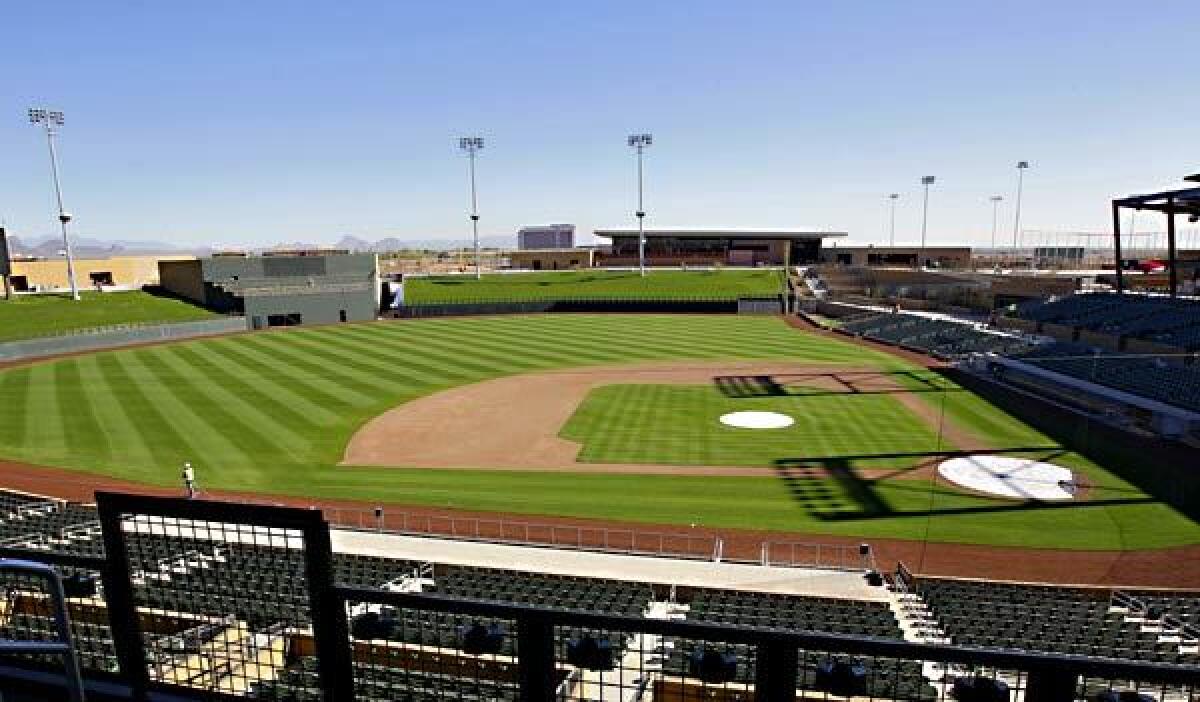Arizona spring training ballpark ‘bringing baseball back home’ to Indian land

- Share via
Reporting from Scottsdale, Ariz. — The paint has barely dried on the Dodgers’ new spring training digs in Glendale, Ariz., and another new venue is making its debut in Arizona’s Cactus League.
Salt River Fields at Talking Stick, the third new ballpark in Arizona’s spring circuit in the last three years, is the new spring home of the Arizona Diamondbacks and Colorado Rockies. The first Major League facility to be built on Native American land, it’s on the Salt River Pima-Maricopa Indian Community bordering Scottsdale.
The arrival of the Diamondbacks and Rockies at Salt River Fields consolidates all 15 Cactus League teams in the Phoenix metropolitan area and makes the Diamondbacks and Rockies neighbors with their National League West division rival San Francisco Giants at Scottsdale Stadium.
The recession had not yet taken its toll when plans were drawn up and funding approved for the Dodgers/Chicago White Sox Camelback Ranch and Cleveland Indians/Cincinnati Reds in Goodyear Ballpark, which opened in 2009. (The Reds moved to the new facility in 2010.)
Construction began on Salt River Fields in November 2009, which may not have seemed the best time to undertake a project, but financing the more than $100-million Salt River Fields did not require municipal funding, contributions from the Arizona’s Sports and Tourism Authority or money from either of the teams outside of their lease agreement.
The opening of Casino Arizona in 1998 improved the quality of life in the Salt River Indian Community, whose borders now blend seamlessly with Scottsdale’s.
I spent a night in November at the Talking Stick Resort (9800 E. Indian Bend Road) just across the Arizona Highway 101 loop from Salt River Fields. From the window of my room, I could see the new ballpark rising in the distance. If I hadn’t known what it was, I might not have recognized it as such. The park seemed almost disguised, its seats tucked below street level and concealed by a large roof structure.
In creating Salt River Fields, the designers at Dallas-based firm HKS, which also drew the blueprints for the Dodgers’ Camelback Ranch, incorporated a combination of design elements from other ballparks and historic Native American architecture.
Although it is in the heart of a large metro area, in keeping with the Cactus League’s panoramic tradition, Salt River Fields is also surrounded by mountains in all directions. A signature feature of the ballpark’s design is the large ramadas that cover most of the seating bowl.
“Our Pima ancestors, the Huhugam, used posts hewn from mesquite trees, with willow and arrow weed branches, to build large ramadas that created shade from the hot desert sun,” said Diane Enos, president of Salt River Pima-Maricopa Indian Community. “These shade structures were important centers for daily life, like cooking, weaving or visiting.”
Salt River Fields may be modern Native America’s first foray into Major League baseball, but ball games and ball and stick rituals have been part of life on the American continents for more than 2,000 years. In fact, ball courts created by Arizona’s indigenous peoples existed within a few square miles of where the Salt River Fields ballpark stands today.
“Bringing baseball back home” is how Levi Long, a spokesman for the Salt River Pima-Maricopa Indian Community, explains the presence of Salt River Fields on Native American land.
Preliminary research took the ballparks’ designers to the Casa Grande Ruins National Monument (home to the ancient civilization of the Hohokam people), in Coolidge, about halfway between Phoenix and Tucson. Not so coincidentally, this is the site of the state’s most prominent historic ball courts.
Archaeologists unearthed its hard surface in 1918, but at first they didn’t realize this might have been a ball court. It wasn’t until a much larger court with definitive markers was discovered at Snaketown on the Gila River Indian Community near Phoenix during an excavation in the 1930s that the ballcourts were recognized as such.
The game played on Arizona’s ancient ball courts might have more closely resembled basketball than baseball but an apt analogy can still be made connecting the ancient ball courts to modern spectator sports.
At Casa Grande I toured with archaeologist Doug Craig, an investigator with Northland Research Inc., a private environmental consulting firm. Craig said more than 240 ancient ball courts had been discovered across the state.
“The whole Phoenix area was the center of the ball court tradition in the area,” he said. “There were prehistoric villages and within the villages there would have been a central plaza and within that central plaza was at least one ball court....
“There were ball courts throughout the state with stadium-like features in terms of bringing the public together in a public arena with the equivalent of snack bars and pre- and post-game feasts that could be considered precursors to modern tailgate parties.”
As for such parties, the Dodgers will make their first appearance at Salt River Fields against the Colorado Rockies on March 7. The Angels will get their first look at the place against the Diamondbacks on March 16 and will face the Rockies on March 20. The Dodgers will play a night game at Salt River Fields on March 21.
More to Read
Sign up for The Wild
We’ll help you find the best places to hike, bike and run, as well as the perfect silent spots for meditation and yoga.
You may occasionally receive promotional content from the Los Angeles Times.






